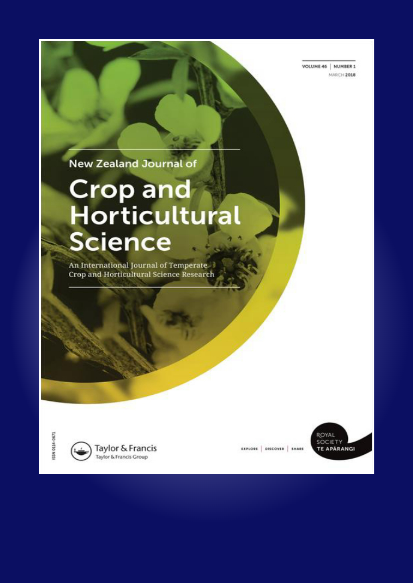对巴西南部暖冬条件下8种苹果树降温模式的调查
IF 1.5
4区 农林科学
Q3 AGRONOMY
New Zealand Journal of Crop and Horticultural Science
Pub Date : 2023-07-03
DOI:10.1080/01140671.2021.2006241
引用次数: 0
摘要
摘要用于估算巴西温带果树整个休眠期冷积累的主要模型是在北半球温带地区开发的。因此,在冬季温和的地区使用时,它们的精度较低。然而,有几个鲜为人知的模型更精确。本研究旨在评估八种不同的冷积累估计模型对五个苹果品种的精度,这些苹果品种在温和的冬季地区嫁接在两个不同的砧木上。基于变异系数,使用Microsoft Excel®程序评估以下模型的精度:犹他州、改良犹他州、CH < 7.2°C,CH < 10°C,CH < 15°C,低冷,台湾低冷和每日阳性犹他州冷机组(PCU)。犹他州和CH两个模型的精度最低 < 7.2°C(巴西最常见的模式)。CH型 < 15°C,台湾低冷、低冷和改良犹他州被认为是精确的(变异系数 < 15%的年冷积累,并评估克服品种休眠的要求)。在‘M-26’和‘M-9’砧木之间没有观察到模型精度的重要差异。本文章由计算机程序翻译,如有差异,请以英文原文为准。
A survey of eight chilling models for apple trees in Southern Brazil under mild winters
ABSTRACT The main models used for estimating chill accumulation throughout the dormancy period of temperate fruit trees in Brazil were developed in temperate regions in the northern hemisphere. Thus, they exhibit low precision when they are used in regions with mild winters. However, there are several little-known models that are more precise. This study aimed at evaluating the precision of eight different estimation models of chill accumulation applied to five apple cultivars which were grafted on two distinct rootstocks in a region with mild winters. Based on the coefficient of variation, the Microsoft Excel® program was used for evaluating the precision of the following models: Utah, modified Utah, CH < 7.2°C, CH < 10°C, CH < 15°C, Low chill, Taiwan low chill and Daily positive Utah chill unit (PCU). The lowest precision was attributed to both models Utah and CH < 7.2°C (the most common model in Brazil). Models CH < 15°C, Taiwan low chill, Low chill and modified Utah were considered precise (coefficient of variation < 15% in annual chill accumulation and to evaluate requirement to overcome dormancy in cultivars). No important differences were observed in models precision between ‘M-26’ and ‘M-9’ rootstocks.
求助全文
通过发布文献求助,成功后即可免费获取论文全文。
去求助
来源期刊
CiteScore
2.90
自引率
7.70%
发文量
54
审稿时长
>36 weeks
期刊介绍:
Scope of submissions: The New Zealand Journal of Crop and Horticultural Science publishes original research papers, review papers, short communications, book reviews, letters, and forum articles. We welcome submissions on biotechnology, entomology, plant nutrition, breeding and pathology, postharvest physiology, soil science, viticulture, biosecurity, new crop and horticultural products, and descriptions of new cultivar releases. The journal welcomes work on tree and field crops, and particularly encourages contributions on kiwifruit, apples and wine grapes.

 求助内容:
求助内容: 应助结果提醒方式:
应助结果提醒方式:


